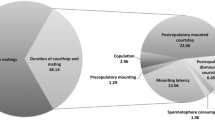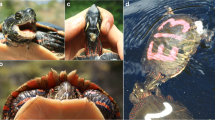Synopsis
The mating behavior and dentition ofUrolophus halleri, the round stingray was examined. Males frequently bite females during the mating period but most male biting does not result in copulation. In bites that do not lead to copulation, males bite the posterior (or occasionally the medial) portion of the females' disc but females often free themselves from these bites. In bites that precede copulation, males bite the anterior portion of the females' disc and females do not struggle to free themselves. Thus, females may exert some form of choice when they are bitten. Mature males have sexually dimorphic dentition that may aid in holding females. A principal component analysis (PCA) showed that in juvenile males, the relative size of the teeth decrease while the relative thickness of the disc increases as body size enlarges; adult males displayed no clear pattern. In adult females, there is a relative decrease in tooth size and increase in relative disc thickness as body size enlarges. The relative increase in females disc thickness in areas where they are bitten may function to minimize the amount of damage due to non-copulatory biting. There is no indication that biting functions to induce female receptivity but it may allow females and males to acquire information about potential mates. Thus, copulatory biting functions to maintain contact during copulation while the function of non-copulatory biting is less clear.
Similar content being viewed by others
References cited
Babel, J.S., 1967. Reproduction, life history, and ecology of the round stingray,Urolophus halleri Cooper. State of Calif Dept. Fish and Game Bulletin 137: 1–104.
Baxter, R.M. & J. Meester. 1982. The captive behavior of the red musk shrew,Crocidura flavescens flavescens (Sorcidae:Crocidurinae). Mammalia 46: 11–28.
Bigelow, H.B. & W.C. Schroeder. 1953. Fishes of the western North Atlantic: sawfishes, guitarfishes, skates, and rays. Sears Mem. Found. Marine Res. No. l Part 2. 588 pp.
Bookstein, F.L., B. Chernoff, R.L. Elder, J.M. Humphries, G.R. Smith & R.E. Strauss. 1985. Morphometrics in evolutionary biology. Spec. Publ.15, Acad. Nat. Sci. Phila. 277 pp.
Budker, P. 1971. The life of sharks. Weidenfeld and Nicolson, London. 222 pp.
Carpenter, C.C. & G.W. Ferguson. 1977. Variation and evolution of stereotyped behavior in reptiles. pp. 335–554. In: C. Gans & D.A. Tinkle (ed.) Biology of the Reptilia, Vol. 7, Academic Press, London.
Castro, J.I., P.M. Bubucis & N.A. Overstrom. 1988. The reproductive biology of the chain dogfish, Scyliorhinus retifer. Copeia 1988: 740–746.
Churchfield, S. 1990. The natural history of shrews. Comstock Publ. Assoc., Ithaca. 178 pp.
Clark, E. 1963. The maintenance of sharks in captivity, with a report on their instrumental conditioning. pp. 145–146. In: P.W. Gilbert (ed.) Sharks and Survival, D.C. Health and Co., Boston.
Clark, E. 1975. The strangest sea. Natl. Geo. Mag. 148: 338–343.
Cox, C.R. & B.J. Le Boeuf. 1977. Female incitation of male competition: a mechanism of sexual selection. Amer. Nat. 111: 317–335.
Dempster, R.P. & E.S. Herald. 1961. Notes on the horn sharkHeterodontus francisis with observations on mating activities. Occ. Papers Cal. Acad. Sci. 33: 1–7.
Feduccia, A. & B.H. Slaughter. 1974. Sexual dimorphism in skates (Rajidae) and its possible role in differential niche utilization. Evolution 28: 164–168.
Gudger, E.W. 1912. Summary of work done on the fishes of Tortugas Carnegie Inst. Wash. Year Book 11: 148–150.
Houck, L.D. 1980. Courtship behavior in the plethodontid salamander,Desmognathus wrighti. Amer. Zool. 20: 825.
Houck, L.D. & N.L. Reagan. 1990. Male courtship pheromones increase female receptivity in a plethodontid salamander. Anim. Behav. 39: 729–734.
Hunte, W., R.A. Myers & R.W. Doyle. 1985. Bayesian mating decisions in an amphipod,Gammarus lawrencianus Bousfield. Anim. Behav. 33: 366–372.
Kleiman, D.G. & J.F. Eisenberg. 1973. Comparisons of canid and felid systems from an evolutionary perspective. Anim. Behav. 21: 637–659.
Klimley, P.A. 1980. Observations of courtship and copulation in the nurse shark, Ginglymostoma cirratum. Copeia 1980: 878–882.
Libby, E.L. & P.W. Gilbert. 1960. Reproduction in the clear nosed skate,Raja eglantaria. Anat. Rec. 138: 365.
Luer, C.A. & P.W. Gilbert. 1985. Mating behavior, egg deposition, incubation period, and hatching in the clearnose skate,Raja eglantaria. Env. Biol. Fish. 13: 161–171.
McCourt, R.M. & A.N. Kerstitch. 1980. Mating behavior and sexual dimorphism in dentition in the stingray Urolophus concentricus from the Gulf of California. Copeia 1980: 900–901.
McEachran, J.D. 1977. Reply to ‘Sexual dimorphism in skates (Rajidae)’. Evolution 31: 218–220.
McEachran, J.D., D.F. Boesch & J.A. Musick. 1976. Food division within two sympatric species-pairs of skates (Pisces:Rajidae). Marine Biology 35: 301–317.
Nordell, S.E. 1990. The courtship and mating behavior of the round stingray, Urolophus halleri (Cooper). Master's Thesis, University of Arizona, Tucson. 47 pp.
Pearson, O.P. 1944. Reproduction in the shrewBlarina brevicauda. Amer. J. Anat. 75: 39.
Pratt, H.L. Jr. 1979. Reproduction in the blue shark,Prionace glauca. U.S. Fish. Bull. 77: 309–376.
Price, K.S. Jr. 1967. Copulatory behavior in the clearnose skate, Raja eglanteria, in lower Chesapeake Bay. Copeia 1967: 854–855.
Promislow, D.E.L. 1987. Courtship behavior of a plethodontid salamander,Desmognathus aeneus. J. Herp. 4: 298–306.
Reed, J.C. & R.G. Gilmore. 1981. Inshore occurrence and nuptial behavior of the roughtail stingray,Dasyatis centroura (Dasyatidae), on the continental shelf, east central Florida. Northeast Gulf Science 5: 59–62.
Riedman, M.L. & J.A. Estes. 1990. The sea otter (Enhyudra lutris): behavior, ecology, and natural history. Biological Report (Fish and Wildlife Service, U.S. Dept. of Interior, Washington) 90 (14): 2–90.
Schmidtlein, R. 1978. Beobachtungen über die Lebensweise einiger Seethiere innerhalb der Aquarien der zoologischen Station. Mitt. Zool. St. Neapel 7: 1–27.
Sokal, R.R. & F.J. Rohlf. 1981. Biometry, 2nd edition. Freeman, San Francisco. 859 pp.
Springer, S. 1960. Natural history of the sandbar shark,Eulamia milberti. U.S. Fish. Bull. 61: 1–38.
Springer, S. 1967. Social organization of shark population. pp. 149–174. In: P.W. Gilbert, R.F. Matheson & D.P. Rall (ed.) Sharks, Skates, and Rays, Johns Hopkins Press, Baltimore.
Stevens, J.D. 1974. The occurrence and significance of tooth cuts on the blue shark (Prionace glauca L.) from British waters. J. Mar. Biol. Assoc. U.K. 54: 373–378.
Strauss, R.E. 1990. Predation and life-history variation inPoecilia reticulata (Cyprinodontiformes: Poeciliidae). Env. Biol. Fish. 27: 121–130.
Suda, A. 1953. Ecological study on the blue shark (Prionace glauca Linne). South Sea Area Fish. Res. Lab. Rep. 26: 1–11.
Taylor, L.R. Jr. 1971. Shark sex. Fish Life 2: 17–24.
Thomson, D.A., L.T. Findley & A.N. Kerstitch. 1987. Reef fishes of the Sea of Cortez. The Univ. of Arizona Press, Tucson. 302 pp.
Tricas, T.C. 1980. Courtship and mating-related behaviors in myliobatid rays. Copeia 1980: 553–556.
Tricas, T.C. & E.M. Le Feuvre. 1985. Mating in the reef white-tip sharkTriaenodon obesus. Mar. Biol. 84: 233–237.
Wourms, J.P. 1977. Reproduction and development in chondrichthyan fishes. Amer. Zool. 17: 379–410.
Author information
Authors and Affiliations
Rights and permissions
About this article
Cite this article
Nordell, S.E. Observations of the mating behavior and dentition of the round stingray,Urolophus halleri . Environ Biol Fish 39, 219–229 (1994). https://doi.org/10.1007/BF00005124
Received:
Accepted:
Issue Date:
DOI: https://doi.org/10.1007/BF00005124




